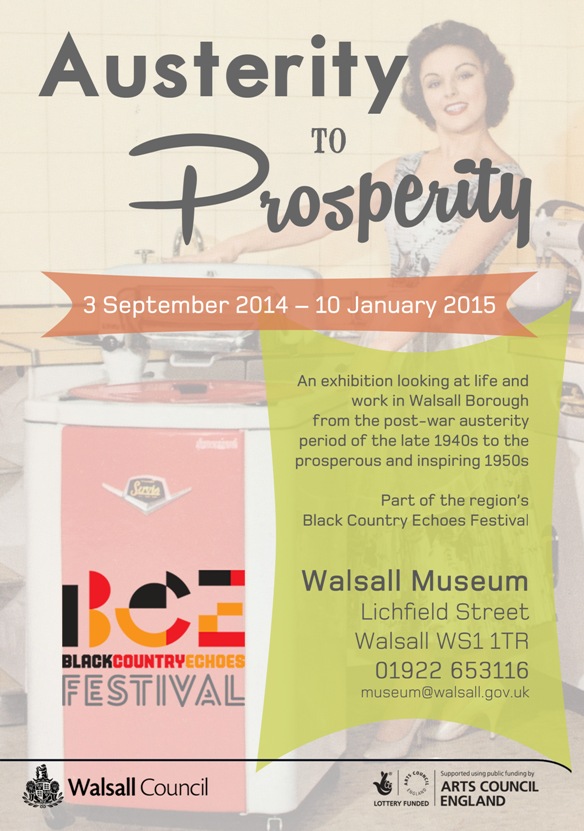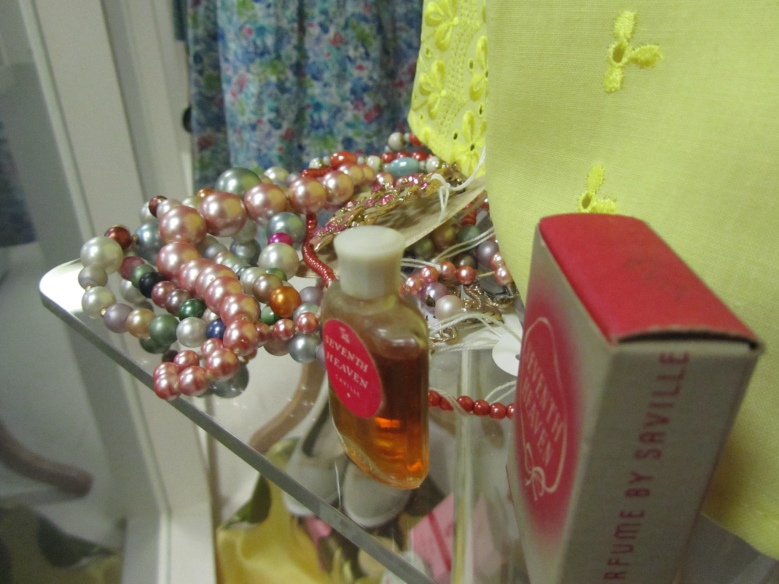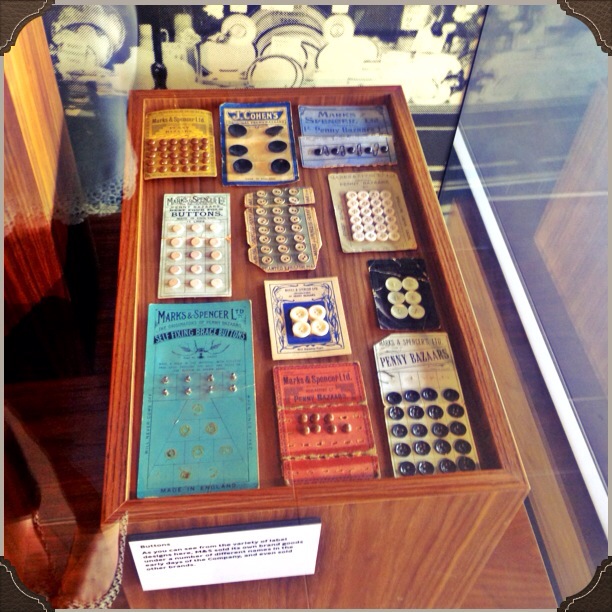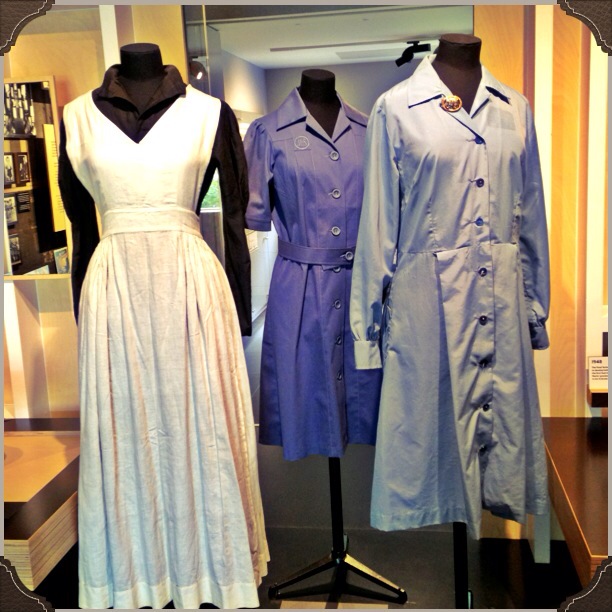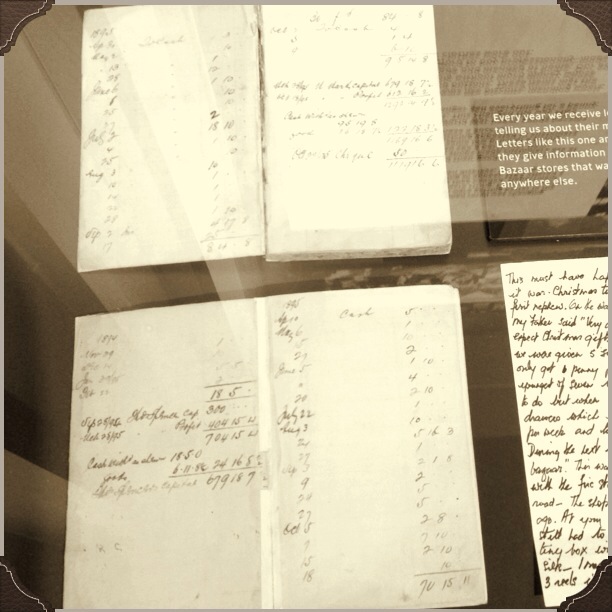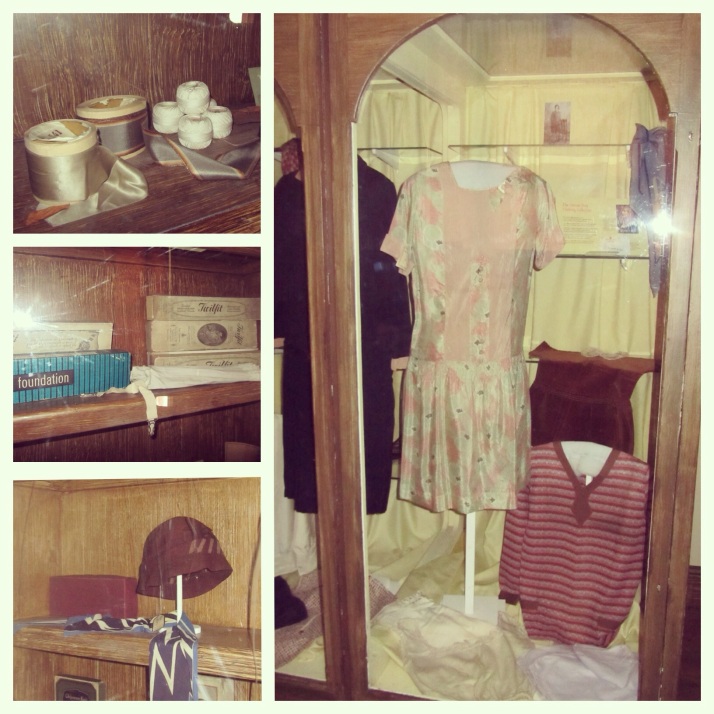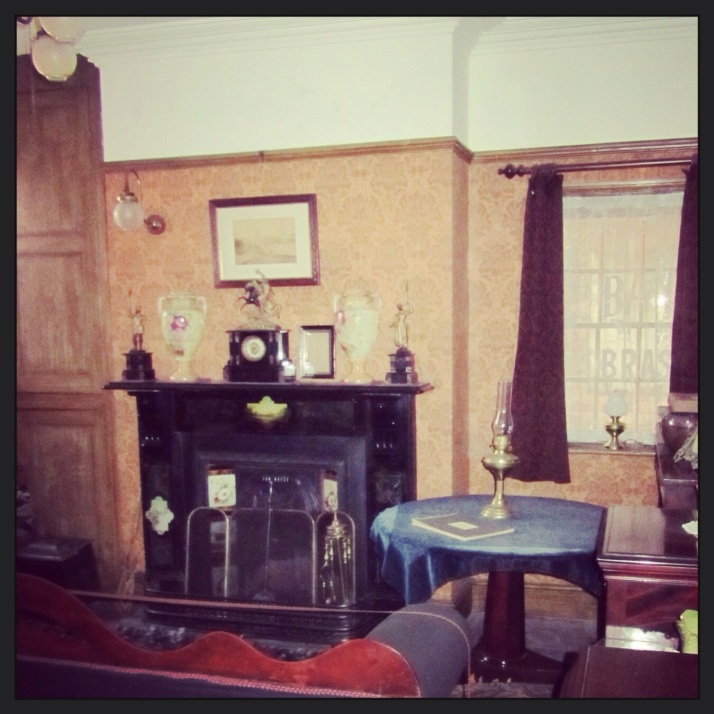Category: Exhibitions
Exhibition: Austerity to Prosperity
I was honoured and excited when Walsall Museum invited me to take part in planning this exhibition. My brief was to select items from the Hodson Shop Collection that told the story of the transition from wartime austerity to the relative prosperity of the 1950s. The clothing in the collection fits perfectly within this tumultuous period and provides evidence of what Black Country women were wearing during the post-war period. There are the simple yet subduedly elegant utility (CC41) dresses that fade away as the 1950s get into full swing, with full skirts and vivid prints taking over.
My main aim was not to oversimplify the narrative of change; the myth that everyone woke up on 1st January 1950 to find that the drab wartime world had been replaced by a new consumer-driven technicolor dream world. The 1940s may have been a time of austerity but there was still colour, beauty and a booming demand for little luxuries such as lipstick and face powder. Conversely, the 1950s remained austere for many, with food rationing only coming to an end in 1954 (clothing rationing ended in 1949). I reflected this by choosing a few unusual items: a ‘Wartime emergency pack’ of face powder, a surprisingly frilly utility dress, a distinctly dreary wool jersey dress from the 1950s next to a full-skirted confection of a dress from the same time.
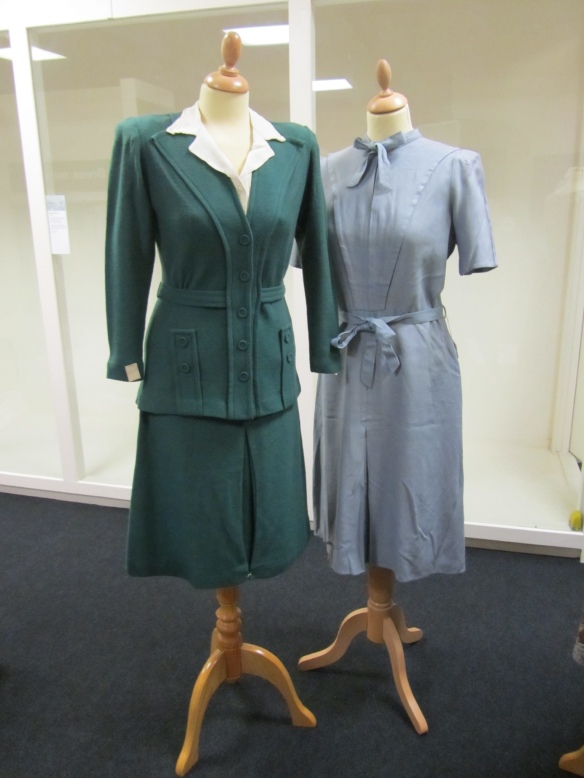
Utility items from the Hodson Shop Collection – creases have been kept in the dress as that is how it was discovered in the Hodson Shop.
Installing the exhibition was great fun and an excellent learning opportunity. I’m really proud of the end result, especially the bit that includes a 1950s twin-tub washing machine!
The clothing accompanies a display of items manufactured or used in the Black Country during the period 1940-1960, again reflecting the aesthetic and ideals of the shift from austerity to prosperity. The exhibition is part of the region-wide Black Country Echoes festival and runs 3 Sept-10 Jan 2015. Admission is free.
Thanks to the team at Walsall Museum for providing me with this opportunity and supporting me along the way!
From Austerity to Prosperity
3 Sept 2014-10 Jan 2015
Community History Gallery, Walsall Museum, Lichfield Street, Walsall.
Current Exhibition: Red! @ Walsall Museum

From left: printed cotton day dress, c.1951 (Hodson Shop Collection), red grosgrain short evening dress with roses, c.1958.
Sometimes it is the simplest ideas that prove to be the most effective, as evidenced by Walsall Museums latest dress exhibition: Red!
As you might have figured from the title, the exhibition is a celebration the colour red, most specifically the iconic red dress.
All of the dresses have been drawn from Walsall Museum’s massive costume collection and include several items from the Hodson Shop Collection. The dresses are organised in chronological order, starting with this stunning striped muslin day dress from the 1850s (pictured below) and working their way up to this slinky satin wrap dress from the early 1990s (I love the fact that this dress is from Etam). And somewhere in the middle is this grosgrain Wishick and Webber stunner from 1958 (pictured top right).
Hodson Shop dresses include a 1920s cotton day dress with a pointed collar and daisy print, aCC41 (utility) rayon crepe dress with a belt and button details and a 1950s floral print day dress, scattered with stripes and roses (pictured top left). Even though the Hodson dressed are far from the glitziest items on display, they certainly manage to hold their own amongst the frills and flounces.
The visual impact of the colour is undeniable, whether the dress is a glitzy beaded flapper number or a simple utility dress. It is a great starting point for planning outfits for the upcoming party season!
Red! runs until 18th January 2014 at Walsall Museum, Changing Face of Walsall Gallery on the first floor of the Walsall Central Library building. Admission is free! See What’s On Walsall for more details.
The M&S Archive and CHORD 2013
What does the Hodson Shop have in common with Marks and Spencer? “Not a vast amount beyond selling clothes” would have been my initial answer but that has changed somewhat since spending a day at the M&S Archive.
I was there for the CHORD 2013 conference on historical perspectives around retailing and the senses. The papers were fascinating, as ever. I particularly enjoyed Anneleen Arnout’s paper on the sensory aspects of the Galeries Saint-Hubert in 19th century Brussels and Ai Hisano’s history of cellophane in US food packaging. Ben Highmore’s take on Habitat’s “sensual orchestration” really got me thinking about shops as both retail and educational spaces – where people learn about design through their senses. There are clear parallels with museums within this, though this post isn’t the place for me to ramble on about those!
Instead, I want to tell you all about the M&S Archive and explain how it links with the Hodson Shop Project.
The archive contains approximately 70,000 items and is located within the Michael Marks building, University of Leeds. There’s an exhibition space on the ground floor, which is well worth a visit. The display cases contain items that tell the story of M&S over the decades – from the Penny Bazaars of the 1890s to the present day of Per Una and Percy Pigs. Researchers can also arrange access to the collections and there are excellent facilities for study.
There were some fabulous items on display. I couldn’t get over the floral print on this pair of early “Shapewear” pants (above)! The knitted swimwear from the 1920s also raised a few smiles. Yet it wasn’t all about clothing. In fact, garments only account for 1,700 items within the archive, with the rest being mainly documents relating to management, finance and product design and innovation.
Our guide, Katherine Carter explained to us that it is often a mad scramble to ensure that evidence and artefacts are collected and archived due to the fast pace of 21st century retail. Their collecting policy for clothing is to keep samples of ‘high volume sellers’ (this could be something as simple as a plain white t-shirt), garments seen on celebrities and public figures (e.g. Samantha Cameron’s polka dot dress) and garments incorporating significant innovations in textile technology.
We got to look at the ‘strong room’ where the collection is stored. I was impressed by the high-tech racking system they have in place and the pristine orderliness of the clothing collection. The garments may not have huge monetary worth and be distinctly ‘everyday’ but M&S clearly value their history.
During our tour of the exhibition space, Katherine explained how the company had evolved from a market stall in Leeds to the globally recognisable super-brand of today. It is strange to think that one of the earliest big sellers was sheet music that sold for one penny. The inflation of the 1920s made the ground breaking ‘everything’s a penny’ sales strategy impossible to maintain, leading the company to diversify and experiment with new products and branding. They introduced their first bra in 1926 and started to sell a range of simple, loose fitting garments (the loose fit was necessary due to the infancy of mass production techniques).
I was intrigued to hear that M&S technologists had worked with the government during WWII to develop what would become the CC41 (utility) scheme. It was striking to see a simple, yet elegant, utility dress next to the full and flouncy fifties floral frock. Katherine used the phrase ‘wonder fabrics’ when talking about the scientific breakthroughs of the fifties that kick started the period love affair with man-made fibres.
The 1960-1970s case was a delight. It was amusing to see how the company had attempted to keep up with the youthful freedom of the period – their first campaign with Twiggy was launched in 1968, whilst their Young St Michael range was endearingly innocent and ever-so slightly wide of the mark!
Ready meals and convenience foods were highlighted as the next major breakthrough. The not very appetisingly named ‘Boil in the Bag Ravioli’ was launched in 1971, with Indian ready meals and lasagnes following in 1972. Apparently, they were edible status symbols – with high price tags.
Fast-forwarding to 2009 and M&S celebrated the 150th anniversary of Michael Marks’ birth. The display featured limited edition archive-based garments. This anniversary marked the point when the design team began to search through the archives for creative inspiration.
There were also displays of staff uniforms from across the decades – from the early floor length black dresses worn with crisp white aprons, to the man-made fibre extravaganzas of the 1950s. A visitor assistant called Janet kindly talked me through these displays. She had worked for M&S since she was a teenager and even showed me a picture of her young self in a smart M&S uniform! She told me how her employers trained her in everything from grooming to dental hygiene. There is a clear sense of ‘family’ amongst M&S employees.
Janet also pointed me to a cabinet containing diaries belonging to Michael Marks and Tom Spencer for 1894 (the first year of the partnership). They detail Tom Spencer’s initial £300 investment in the company – humble items that capture a turning point in retail history.
So what exactly do the Hodson Shop Collection and M&S archive have in common? My first thought was that they are both collections of stock and documentation of a single business. They also cover a similar time period. In both cases, items are not spectacular, expensive or glamorous. The garments in the M&S collection are not displayed in relation to a specific wearer – making them, in a sense, ‘unworn’ (I would love to establish how many of the garments in their collection have been worn and how many have not). On a more practical level, I noticed that some of the brands featured in earlier displays were the same as found in the Hodson Shop Collection, such as Dewhurst’s and St Margaret (the latter being the inspiration behind the St Michael brand name which was dropped in 2000).
Whilst there are some parallels, I am aware that the items in the M&S archive are there due to their association with a much-loved and renowned brand and business. Michael Marks and Tom Spencer have a lofty position in retail history whilst Edith and Flora Hodson are minor players. People visit the M&S exhibition because it resonates with them on a personal level and this resonance is widespread, across the country and generations.
Massive thanks to: the team at the M&S archive (especially Katherine and Janet), Laura Ugolini and Karin Dannehl from University of Wolverhampton who organised the CHORD conference and all of the speakers at the event.
A Visit to the Hodson Shop
54 New Road, Willenhall was the site of the Hodson Shop. The building is now in the care of the Black Country Living Museum (BCLM) and goes by the name The Locksmith’s House due to Edgar Hodson’s successful lock making business that operated from the same site.
The house isn’t normally open to the public, so I jumped at the chance to go on a special visit with historian Rod Quilter. I spent a wonderful afternoon exploring 54 New Road. It felt odd to be in a place that I have read and written so much about.
Stepping into the shop, which now functions as a reception area/gift shop/mini exhibition space I was instantly struck by how small it was. My only previous experience of the space had been from a black and white photo taken in 1983 – whoever took it had obviously applied estate agent style photographic skills!
There was display case of 1920s clothing and shelves in alcoves to either side of the fireplace. In fact, the fireplace was my only real point of reference from the photograph; the display units were all new additions. The shelves held corsetry, accessories and haberdashery items – everything on display had been loaned from Walsall Museum. A door between the shop and neighbouring parlour had been filled in. The shop was accessed from the street by walking through the front door and walking a short way down a stone-floored hallway. It seemed strange for the shop to share an entrance with the rest of the house, as if the boundaries between personal and business spaces were blurred.
The parlour had been recreated with a combination of reproduction soft furnishings and original furniture. There was a booklet of photographs on a small table; it contained images of the Hodson family including a stunning photograph of a youthful Flora Hodson.
We went upstairs to a small office space; it was next door to the master bedroom – again with the blurred lines between business and private life. The bedroom was quite poignant, it was where Flora Hodson slept, alone in the house, following the death of her sister and brother.
Edgar Hodson’s lock making business is the focal point of the property. We were lucky to get a tour of his factory and some facts about lock making from a volunteer called Andy who is a locksmith himself and runs demonstrations for visitors. It turns out that Edgar supplied locks all over the world, including a booming business in Latin America.
It was fascinating to walk through the house and it got me thinking about how the collection has become separated from its original environment. I am very interested in how the historical narrative of lockmaking has been prioritised over one of shop keeping and clothing. On a more practical level, I am struggling to imagine how the collection once fitted into such a compact space!
As mentioned above, the house isn’t generally open to the public – school and group visits can be arranged by contacting the BCLM. However, the house has an annual free open day complete with tours and lock making demonstrations. The next one is Saturday 14th September, 10am-4pm. I’d highly recommend it.
Massive thanks to Jo Moody and Andy at BCLM, Catherine Lister at Walsall Museum and Rod Quilter for a wonderful afternoon!
Current Exhibition: Summer on the Beach @Walsall Museum
Fun fact: The Hodson Shop Collection contains no beachwear. I need to do a bit of digging as to why this might be but I have a couple of theories:
1) Willenhall is about as land-locked as a town can be, so a swimming costume would be more of a luxury than a necessity.
2) The Hodson Shop simply wasn’t the sort of place that sold swim wear – maybe bathing suits were purchased from more specialist retailers?
Whilst Edith and Flora Hodson might not have been purveyors of bikinis and bathing costumes, the people of Walsall borough definitely had a desire to splash around at the seaside!
Walsall Museum’s Summer on the Beach exhibition gives a vibrant overview of 20th century beachwear, drawing from the Museum’s extensive Community History Costume Collection.
Can you picture yourself parading along the beach in a psychedelic seventies bikini or sunning yourself in a floral fifties bathing suit with puffed skirt? How about dodging waves in a heavy stockinette Edwardian bathing dress? And for the men they have just the thing for taking a dip, a thick woollen swimming suit.
Summer on the Beach is on show from Thursday 13 June until Wednesday 11 September 2013. It can be seen within Walsall Museum’s Changing Face of Walsall gallery on the first floor of the Central Library building. Entry to the Museum is free of charge, for further information please contact 01922 653116 or email museum@walsall.gov.uk.
Note: The pictures below aren’t from the actual exhibition – they were taken at an event earlier in the year. Both of these swimming costumes feature in the exhibition and give a good idea of the flamboyant and colourful nature of the swimwear. I’m pretty smitten with the butterfly print number!
Current Exhibition: Factory Girls @ Walsall Museum
Aprons and overalls from The Hodson Shop Collection star in Walsall Museum’s latest exhibition, Factory Girls.
The exhibit celebrates these often overlooked aspects of working women’s attire, from 1920s-1970s. Whilst the overalls and aprons served a practical and protective purpose for the women who worked in Walsall’s factories, they were also attractive garments in their own right; with bold and striking prints and cuts that echoed the shape of the era’s fashionable dress.
Factory Girls features a wide variety of overalls, pinafores and aprons worn by women during the 20th century to protect their clothing while out at work. They range from the dress-like overalls of the 1920s, through the classic cross-over pinny styles of the 1930s and 40s to the nylon jacket styles of the 1960s and 70s.
I personally adore the Hodson Shop paisley wrap-around dress-style overall from the 1930s (below, centre) – it manages to be at once practical and relatively elegant, far better than my standard housework attire of scruffy jeans and a hoodie!
It is exciting to see these everyday and instantly recognisable garments on display (did anyone else’s Nan used to answer the door wearing something strikingly similar?!) . They serve as reminders that Walsall’s industrial past, whilst certainly dirty and far from glamorous, was still bright, colourful and beautiful.
Factory Girls runs until 12th June 2013 and is set to complement the upcoming A Centenary of Stainless Steel exhibition that celebrates the renowned Bloxwich-based stainless steel manufacturers, Old Hall which runs 9th April-1st June 2013.
You can visit Factory Girls at Walsall Museum’s Changing Face of Walsall gallery on the first floor of the Central Library building. Entry to the Museum is free of charge, for further information please call 01922 653116 or email museum@walsall.gov.uk.
